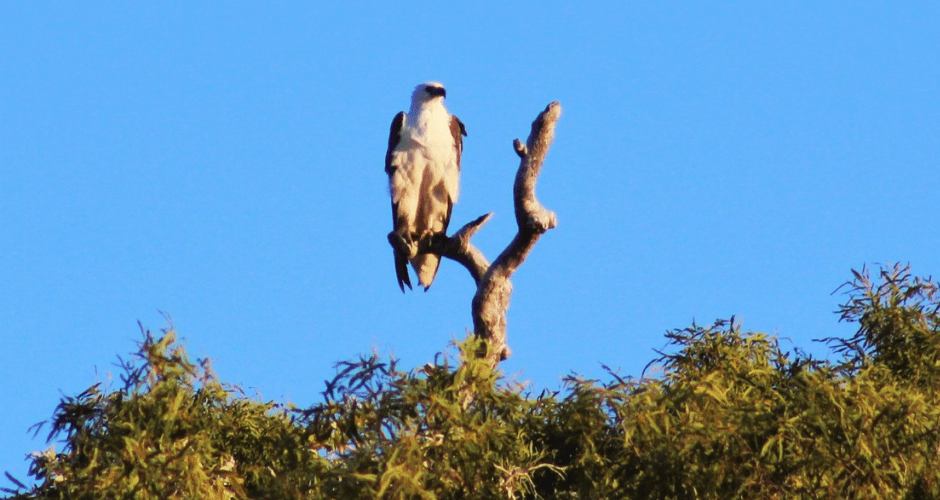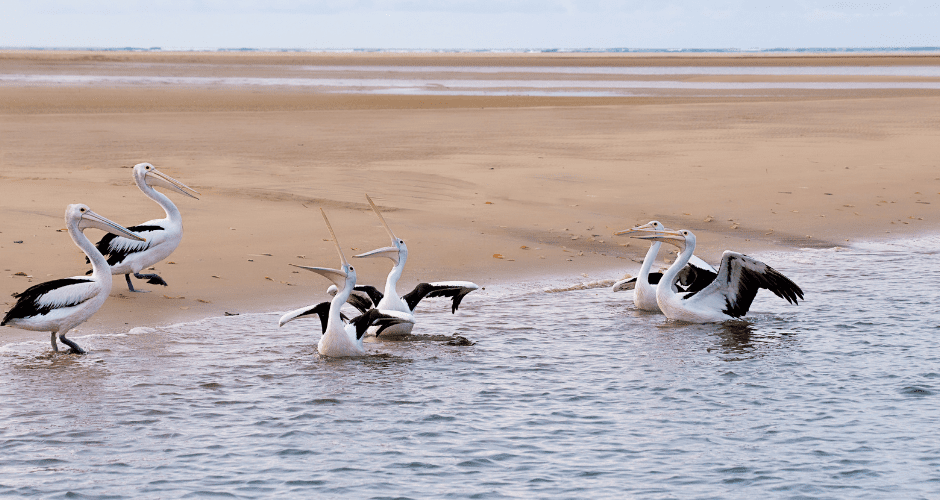24 Feb Birdlife with 1770 LARC! Tours

Birdlife with 1770 LARC! Tours
We can never guarantee wildlife encounters on our LARC tours however, bird sightings are almost a given. With so many birds visiting, nesting or feeding in our area the only thing we can’t do is predict what species you will see. But if you were wondering about the possibilities, we’ve compiled a list below of our regulars. Plus, as a bonus, a few random facts about each one.
Beside each bird name you will also notice some letters in brackets. This relates to their conservation status. The key for which you can find at the end of this article.

Birds of Prey
Brahminy Kite (LC) – Young birds have been observed indulging in playful behaviour, picking up leaves, dropping them in the air and attempting to catch them as they fall.
Osprey (LC) – The only bird of prey that can close its nostrils. Allowing it to dive and fish underwater.
White Bellied Sea Eagle (LC) – This species is monogamous, pairs remaining together until one bird dies, after which the surviving bird quickly seeks a new mate.
Whistling Kite (LC) – Use the same nest every year. Adding to it each season, making them ridiculously large.
Wedge Tail Eagle (LC) – Is that a plane? … no, it’s just the largest bird of prey in Australia. The female can be as much as 33% larger than the male.
 Migratory Waders
Migratory Waders
Eastern Curlew (CR) – Our most endangered visitor on the critically endangered list.
Bar Tailed Godwit (NT) – Has the longest ever record non-stop flight of any bird also the longest without pausing to feed. From Alaska to New Zealand.
Red Necked Stint (NT) – Super friendly sociable birds and will form flocks with other small waders when not in breeding.
Greater and Lesser Sand Plover (LC) – To tell them apart the lesser sand plover is slightly smaller than the greater. But to tell them apart when seen individually is near impossible.
 The Everyday Commons
The Everyday Commons
Pied Oyster Catcher (LC) – Generally seen in pairs. Despite their name, they rarely eat oysters.
Pelican (LC) – This giant sea chicken hangs out in salt and fresh water. During mating season their legs and beaks change colour from peach/pink to blue/purple.
Sea Gulls (LC) – The smaller sea chicken – diet consists solely of hot chips acquired normally by theft, rarely by donation and never by purchase.
Red Cap Plover (LC) – Small but fun and vibrant characters. The males crown becomes bright rusty red during mating season – hence their name.
Sacred kingfisher (LC) – Both sexes excavate the nest, which is normally a burrow in a termite mound.
Striated Heron (LC)– Are known to go fishing using ‘bait’, like a feather or leaf, and carefully placing it on the water’s surface and picking up any fish that come to investigate.
The Rare Sightings
By ‘rare’ we mean birds that we will see only once in a blue moon. Not necessarily because they are threatened but more so because our backyard is not a regular habitat for these species.
Black Necked Stalk (NT) – Often referred to as a Jabiru, however this name is their South American name and refers to a stork species from the Americas.
Black Swan (LC)– Typically a fresh water bird and not seen here, except for once a year. We guess that everyone needs a coastal holiday.
Emu (LC) – The Prehistoric Chicken. During reproduction the male does the incubation of the eggs; during this process he hardly eats or drinks and loses a significant amount of weight. The eggs hatch after around eight weeks, and the young are nurtured by their fathers.
Red Necked Avoset (LC) – Such a funky looking bird and is widely spread around Australia, but for some reason extremely uncommon in the North East.
Beach Stone Curlew (NT) – A rare sighting because curlews are typical nocturnal animals. However, the beach stone isn’t as strict as the night screamers and can be occasionally observed active during daylight hours.
That’s just a little taster of our teams’ favourites. Please note: Bird sightings are not limited to just what we have included here, there’s just too many to list!
International Union for Conservation of Nature
Red list for threatened species.

- Extinct(EX) – beyond reasonable doubt that the species is no longer extant.
- Extinct in the wild(EW) – survives only in captivity, cultivation and/or outside native range, as presumed after exhaustive surveys.
- Critically endangered(CR) – in a particularly and extremely critical state.
- Endangered(EN) – very high risk of extinction in the wild, meets any of criteria A to E for Endangered.
- Vulnerable(VU) – meets one of the 5 red list criteria and thus considered to be at high risk of unnatural (human-caused) extinction without further human intervention.
- Near threatened(NT) – close to being endangered in the near future.
- Least concern(LC) – unlikely to become endangered or extinct in the near future.

No Comments